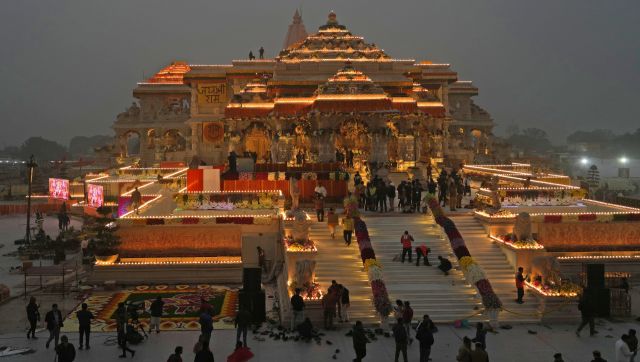Dawn is yet to streak across the horizon but at 4.30 am at The International Society for Krishna Consciousness (ISKCON) temple at Juhu, the air is thick with the fragrance of flowers, burning incense sticks and the clash of cymbals and drums to the rhythmic loud chants of Hare Krishna, Hare Rama. There is a clutch of devotees who sway and clap their hands as they chant. As the day progresses, one sees silk clad women with diamonds twinkling on their noses and ears and some celebrities of the city joining in the chant during arati. It is not just the swish set that come to the temple at Juhu but also the poor who pay obeisance to the smiling gods.
ISKCON is famous for its vegetarian food which is also distributed free on special occasions. Last year ISKCON Juhu distributed more than 10 lakh plates of prasadam meal and 60 lakh cups of halva in and outside the temple premises. The prasadam meals are also distributed to the underprivileged during several festivals, as part of Anna Dan Seva initiative during Makar Sankranti, at temple anniversary celebrations and other occasions.
“We are able to give free prasadam meals due to donations that we receive from devotees,” says Mukund Madhav Das, vice president, ISKCON, Juhu. Some of its most celebrated devotees offer their services either through dance and music and funds thus raised are donated to the temple. There are generous donations too made by the devout who visit the temple regularly either through cash or kind or by paying for services such as feeding cows, for free meals for the needy, etc. The temple also raises funds through sale of religious books, its restaurant Govinda in the premises, snacks and bakery shop and gift shop.
Golden Jubilee celebrations
It is the golden jubilee year celebration of ISKCON temples or centres across the globe. ISKCON, also known as the Hare Krishna movement, was founded in New York City by AC Bhaktivedanta Swami Prabhupada in 1966. The Society’s Mumbai center is celebrating its three-day golden jubilee this weekend (5 to 7 February).
Prabhupada was born Abhay Chandra De, who in 1932 became the disciple of Bhaktisiddhanta Sarasvati Thakura. The Gaudiya Vaishnava Society, in recognition of De’s scholarship, bestowed on him the title of Bhaktivedanta – meaning one who has realized that devotional service to the Supreme Lord is the end of all knowledge. Later, he was known throughout the world as AC Bhaktivedanta Swami Prabhupada.
It was on Thakura’s instructions that Prabhupada went to the US in 1965 to propagate the teachings of the Bhagavad Gita. “Prabhupada’s spiritual master wanted the Bhagavad Gita to be known to the world and not to be restricted to India and Hindus,” says Das.
Prabhupada founded ISKCON in 1966 and since then it has expanded to 600 centres across the globe.
The ISKCON Structure
The structure of the religious foundation follows the instructions laid down by Prabhupada. All ISKCON centres must fully comply with all local laws of governance that apply in whichever country they are located.
Each centre has to be self-sustaining. According to Prabhupada’s instructions, no funds received through donations, sale of books, restaurants or gifts and artefacts from one temple can be transferred to another. Each temple has to devise ways to raise funds. Hence the size of the temples depend on the donations from its patrons.
Financial irregularities are avoided through the water-tight structure that is followed at ISKCON, says Das. The day to day running of every temple is the sole responsibility of the temple president. He is responsible for all members who work or serve in the temple and is himself accountable to the local Governing Board Commission (GBC), which does not have much involvement in the day to day running of the temple. The local GBC is accountable to the central GBC.
There are 95,000 initiators (people who have been taken into the fold after being initiated by senior gurus/meditators) across the globe and over 10 lakh life membership holders. Life membership is given to donors, well-wishers and associates who want to listen to _kirtan_s and _satsang_s.
Governing Body Commission
A group of senior devotees take decisions on ISKCON’s policy matters. They form the governing body commission (GBC). The GBC consists of 35-40 members. Most of them are senior devotees who are chosen for their leadership skills or fundraising abilities and other such allied skills. No one member can claim to be the sole decision maker in the GBC. Decisions are arrived at by consensus based on the principles laid down by Prabhupada.
Praghosha Das, currently the president of ISKCON, in an email interview explains the structure of the Foundation.
“The GBC sets the policy and members act as overseers for all of ISKCON’s activities and are responsible for all the 600 centres or temples. They are also the final arbiters on any and all issues that may need clarification and decision,” says Das.
To avoid financial irregularities, most temples have their own methods. At ISKCON Juhu, no petty cash is available on the premises. Every need of the temple is fulfilled through encashing cheques. The _hundi_s or donation boxes are opened when they are full in the presence of the temple committee and also captured on CCTV screens. The cash is then deposited in the temple’s bank account. If gold or any ornaments or gifts in kind are donated to the temple, they are weighed (in case of gold and silver articles) and the value in current terms noted in a register. The items that are donated are deposited in lockers immediately.
“We ensure that temple accounts are regularly scrutinised by internal and external auditors,” says Madhav Das.
The expenses of the executive committee members of the GBC are taken care of by the Foundation. “There is a small annual budget for the Executive Committee of the GBC but individual GBC members have to fund their own expenses. Often that is done via help from the temples they oversee, as well as individual members who are inspired to help,” says Praghosha Das.
Members of each temple are provided maintenance by the temple itself through its own funds. As a general rule, unmarried members are provided their maintenance directly and serving married members via a stipend**.**
Divine intervention
Praghosha Das has an interesting response to the query as to what should ISKCON centres do in case of shortage of funds. “Some of the most exalted devotees of Krishna have commented on this topic; in essence their advice is that if you sincerely absorb yourself in spreading the message of devotion, the message of selfless service to Krishna, then resources will never be an issue. We would have numerous examples of temples seemingly struggling and under great financial pressure and then unexpectedly from out of nowhere donations come or some other means of funding manifests,” he says.
ISKCON has been mired in few cases of misappropriation of funds in the past at some of its centres. “The fundamental understanding of the devotees of Krishna is that everything belongs to Krishna. That is the main guiding force to ensure that all ISKCON members do not misuse the funds of the organisation, which are in effect Krishna’s funds. In addition to that we have systems in place where all are accountable to a higher authority,” explains Praghosha Das.
Perhaps, the devotees have understood the real call of their inner conscience or as Madhav Das puts it succinctly, “We are not here as we failed in life. We are here because we have experienced life and were dissatisfied. Nothing is tempting about leading a religious life than to be disciplined and follow the teachings of the guru one has voluntarily chosen to follow.” Perhaps, that is true.


)




)
)
)
)
)
)
)
)